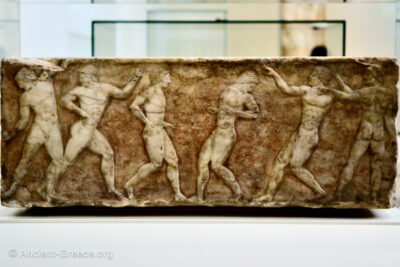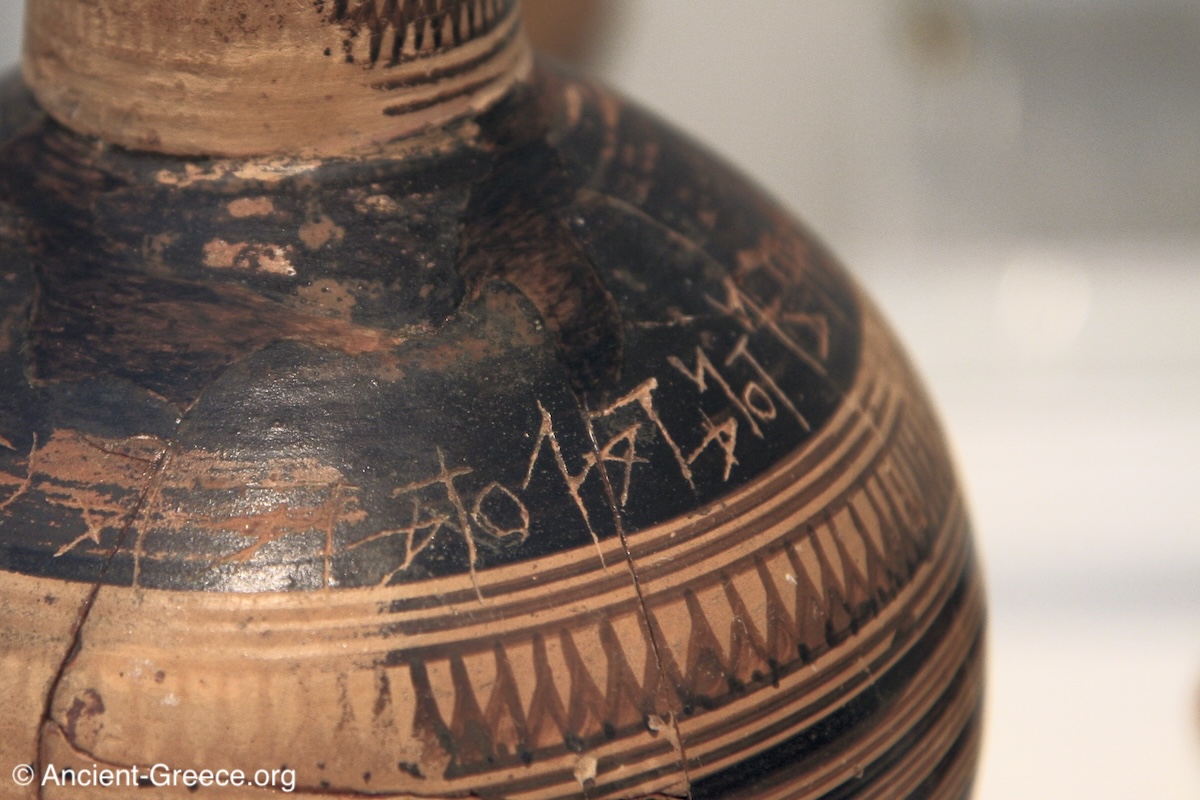
On this page:
The National Archaeological Museum in Athens is hosts to a plethora of art and artifacts from the Dark Ages, the Geometric and Orientalizing periods, and from the Archaic Era, found in excavations in excavations across the country.
While the Dark Ages that succeeded the Mycenaean civilization were times of low cultural development, the later Archaic Era was a period of rapid cultural expansion.
Geometric Era
Left to right:
- Dipylon Amphora. A Monumental Attic grave amphora from Kerameikos cemetery in Athens, by the Dipylon Painter. Geometric Era, circa 760-750 BCE. It is decorated with a funerary scene of prothesis and mourning, among the rows of geometric patterns. In this scene, the deceased is laid flat among lamenting men, women, and children with their hands on their heads in a gesture of despair. This was a common theme in Geometric Era pottery. It is about five feet tall and it was found in Dipylon in Athens.
- Attic Late Geometric krater by the Hirschfeld Painter . Circa 750-735 BCE. On the main zone is depicted the ekphora (carrying out of the body to the grave) of the deceased on a carriage, around which are women mourners and men with swords. From the Dipylon. By the Hirschfeld Painter (750-735 BCE).
- Ivory female (goddess?) figurines from Kerameikos, Athens. Late 8th c. BCE.
Archaic Kouros and Kore Statues
Top row, left to right:
- Kouros statue found in Sounion with comparison to human size. Early Archaic Era (circa 600 BCE).
This kouros statue was found in the Sounion sanctuary. It stood before the temple of Poseidon as a votive offering to the god. It is over life-size (human size included in this photo for comparison) and made of Naxian marble. - Kore Phrasikleia (circa 550 – 540 BCE) and Kouros (circa 540 – 530 BCE). Found buried together in Merenda in Attica.
- Kouros found alongside Kore Phrasikleia. Circa 540-530 BCE.
- Kouros statue. Parian marble. Circa 560-550 BCE.
Second row:
- Anavyssos Kouros. Circa 530 BCE.
Funerary statue for a youth named Kroisos found in Anavyssos, Attica. The inscription on the base reads “Stay and mourn at the monument for dead Kroisos whom violent Ares destroyed, fighting in the front rank.” - Kore Phrasikleia front view. 550-540 BCE.
- Kouros “Aristodikos”. Circa 510-500 BCE.
Made of Parian marble and found in Mesogeia, Attica.
Third row:
- Funerary Kouros. Naxian marble. Circa 550 BCE.
- Kouros statue.
- Kouros from Mt. Ptoon. Circa 520 BCE.
- Kouros from Korrhesia, Kea. Circa 530 BCE.
Fourth row:
- Kouros head. Mid-6th c. BCE.
Made of Thasian marble. Unknown provenance. Purchased from P Chanazoglou. Imported from Constantinople (Kaltsas, Sculptures in the National Archaeological Museum, Athens, 45). - Kore from the sanctuary of Ptoan Apollo in Boeotia. 520 BCE.
- Kouros head. End of 7th c. BCE.
- Statue of a seated goddess with hair combed in the Daedalic style. Circa 630 BCE. Found in Ayiorgitika near Tripoli in the Peloponnese.
Sculpture, Painting, Pottery
Top row, left to right:
- Base of kouros with athletes Relief. 510 BCE.
- Base of kouros with a scene with four athletes. Circa 510 BCE.
Found in Kerameikos. The front of the base depicts this scene with four athletes. Carved of Pentelic marble. - Base of kouros with relief of two seated youths pairing a dog and a cat in a fight. 510 BCE.
- Amphora found at Kerameikos. 600-575 BCE.
Second row:
- Wooden plaque with painting from a cave near ancient Sikyon, in Corinthia. 540-530 BCE.
One of four wooden plaques found in a cave near ancient Sikyon, in Corinthia. The inscriptions reveal that they were dedicated to the Nymphs, the local fertility deities, who were worshipped in the cave.
According to information from the museum: “Painted wooden panels were amongst the most popular forms of cheap dedications in the sanctuaries of the gods. Although they are humble small works, the Pitsa plaques are of great value as the only examples of Corinthian large-scale painting. They are executed in the xerography technique, using mineral pigments. Within the clear black or red outlines of the figures, white, red, blue, yellow, violet, brown, green and black colours were applied solid, with no gradations. The inscriptions recording dedications and names are written in the Corinthian alphabet. Procession to an altar to sacrifice a lamb, accompanied by the flute and lyre. The dedication to the Charites (Graces) can be read, along with the names Euthydika, Eukolis, Etheloncha and, at the side, the name of the painter or dedicator, of which only the place of origin survives: ‘Corinthian’. 540-530 BC.” - Wooden plaque with painting, fragment. 540-530 BCE.
- Three heads of warriors from the Temple of Aphaia in Aegina island, Greece. Circa 490-480 BCE.
- Three heads of warriors from the Temple of Aphaia in Aegina island, Greece. Circa 490-480 BCE.
It was initially believed that they belong to the temple’s pediment. However, later evidence supports that they were part of a group of votive hero statues. - Lion and bull group. About 500 BCE. Plaster cast of a piece now in the Metropolitan Museum of Art in New York. Parian marble. Found in Athens, at the Olympieion. It comes from a pediment.
Third row:
- Grave stele of an anthemion. Late 6th c. BCE.
- Bronze statuette of Athena Promachos. About 500-470 BCE.
Statuette of Athena Promachos (type of the goddess fighting in the first rank). The goddess wears a helmet and the goatskin on the chest. In the left hand she held the shield of which the arm-band survives, and in the right the spear. According to the inscription on the base Meleso dedicated it to Athena giving a tithe of her income. - Bronze statuette of an ithyphallic Silen dancing. 540-530 BCE.
Statuette of a nude ithyphallic Silen dancing ecstatically. He has the features of a man and a horse.
Corinthian workshop. - Bronze warrior figurine figure-of-eight shield. About 700 BCE.
Warrior figurine. He wears an early type of conical helmet and has a figure-of-eight shield of Boeotian type hanging from the baldric on his back. The figurine possibly depicts the hero Achilles. From Karditsa. - Early Greek writing inscription on a cup. Hymettus sherd. 7th c. BCE.
Architectural Elements
Top row, left to right:
- Ionic column capital from the second temple of Athena at Sounion. About 460-450 BCE.
- Ionic column capital with painted double meander detail. With traces of their painted decoration of a double meander and a scaled pattern.From the second temple of Athena at Sounion. About 460-450 BCE.
Second row:
- Ionic column capital from the second temple of Athena at Sounion. About 460-450 BCE.
- Ionic column capital. About 500-490 BCE.
- Archaic Sculptures from a pediment.
- Grave stele of an anthemion. Late 6th c. BCE
Highlights by Era
- National Archaeological Museum in Athens: Overview
- Stone and Bronze Ages 4000 – 1100 BCE
- Iron Age 1100 – 480 BCE
- Classical 480 – 323 BCE
- Hellenistic 323 BCE – 200 CE
Dark ages and Archaic Era: The Iron Age in Greece was a time of radical changes and cultural advancements. While the Dark Ages that succeeded the Mycenaean civilization were times of low cultural development, the later Archaic Era was a period of rapid cultural expansion.
In the 8th century BCE the invention of the Greek alphabet led to a literary revolution never seen before.

During this time Greeks founded a plethora of cities along the entire Mediterranean and the Black sea coasts from Iberia to Lydia, to Crimea. Perhaps the characteristic Kouros and Kore smiles produced during this period reflect a feeling of limitlessness and vigorous extroversion.
In sculpture the human body begins a slow refinement toward a naturalism that continued until the Roman era and beyond. This development is evident in the plethora of Kouros and Kore statues on exhibit. A similar development is also evident in the displayed pottery and its decorations.
Related Pages







































